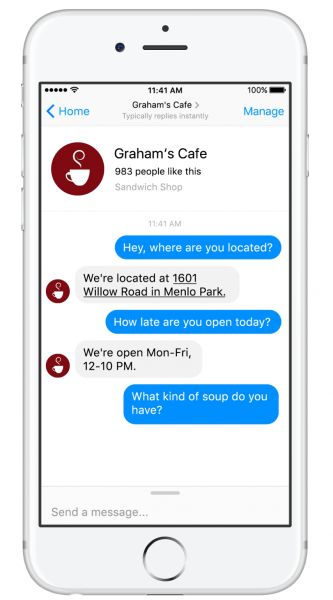Chatbots and the Future of Customer Support
Long-in-development artificial intelligence (AI) technology has been making a splash in the latest generation of chatbots, those computer programs with which you may have interacted in somewhat stilted online customer support conversations. These new offerings, however, boast a new sophistication that promises to bring chatbots to the next level of effectiveness.
At last month’s Shoptalk 2017, AI was the proverbial belle of the ball. When Google is showing off its latest AI-powered voice assistants and eBay’s CEO is begging companies to embrace AI – “If you don’t have an AI strategy,” Devin Wenig proclaimed, “you’re going to die in the world that’s coming” – you know a sea change is underway .
.
At the recent Facebook Developer Conference (F8), the social network titan revealed its big focus on Facebook Messenger. One of the new items they’re rolling out is Smart Replies, a bot-based technology businesses can employ to answer common questions received via Messenger. They also introduced Chat Extensions. These new-and-improved bots are intended to provide users with real-time news and updates, such as live sports scores or, in the support category, ecommerce delivery data. Facebook has prepared for this next step by collaborating with prominent chatbot makers, and plans to open up its APIs so that additional developers can contribute ideas to group chatbot projects.
In India, Microsoft is testing Ruuh, a new AI chatbot aimed at the local English-speaking market. This follows the company’s tactic of releasing market-specific bots. Earlier, the Bing team introduced Xiaoice, a bot for the Chinese market, which was famously pulled from release when users trained it to make racist comments.
That’s not the only danger presented by chatbot misuse. A more-frequently voiced concern about AI, chatbots, and related robot technology is that they’ve been replacing human workers at an overwhelming rate. This has held true in traditional manufacturing industries, but prognosticators see the finance, travel, and retail sectors as prime candidates for the integration of chatbot apps. It makes sense, since these tend to be customer-facing industries that are often heavily reliant upon support interactions. And it won’t stop there: AI programs are also expected to encroach upon a wider swath of sectors, including law, accounting, and healthcare.
So expect to see more of that in play as tomorrow’s chatbots push the envelope of realism. Take the bot developed by Soul Machines, an Australian startup run by the Oscar-winning VFX artist behind Avatar and King Kong. They’re developing lifelike facial expressions for visual customer service chatbots. To top it off, they’ve enlisted Cate Blanchett to provide the voice of their latest assistant avatar, which is powered by IBM’s Watson software. Other in-development chatbots work to figure out one’s emotions by interpreting their voice and speech; in fact, Amazon is looking to integrate this ability with their Alexa product.
With the express purpose of streamlining interactions between people and services, it’s clear that chatbots will play a prominent role in the future of customer service. Clearly, the real motivator, as always, is money. Humans are expensive, and the use of artificial intelligence should eventually cut down on certain costs. But chatbots can’t be seen as the catch-all solution for any organization looking to offer valuable support to its customers. The vital truth is that technology will serve as an augmentation, rather than a replacement, for human interactions. Dr. Ali Parsa, CEO of Babylon Health, which is developing its own AI chatbot, recognizes that it’s probably wiser to let the bots pull information from patients and examine their data, but leave the rest to humans: “A machine can’t put a hand on you and say, ‘Look, I’m going to take care of you.’”
Here at ModSquad, we’re excited about the possibilities. The next decade could see a major shift in how customers expect to engage with brands. Behind the scenes, the most basic tier on a support team could be populated by a bunch of bots. And we’ll be right there with them, building on their foundation and providing the next level of service and support that our clients have come to expect, all with our indomitable human touch.
This entry was posted in Customer Support. Bookmark the permalink.SUBSCRIBE TO OUR BLOG
Get a weekly roundup from the world of ModSquad.
SUBSCRIBE TO OUR BLOG
Get a weekly roundup from the world of ModSquad.